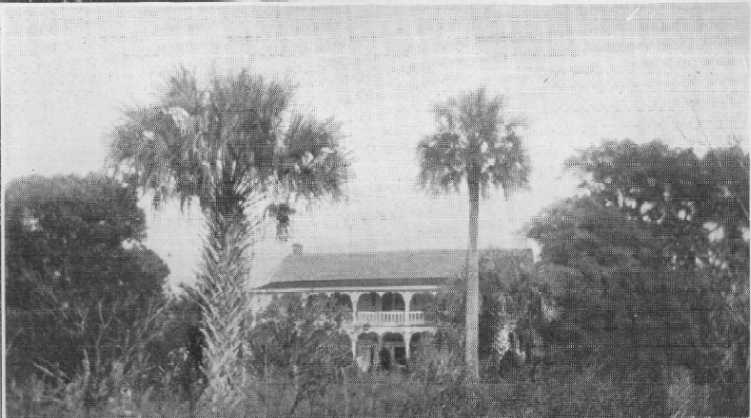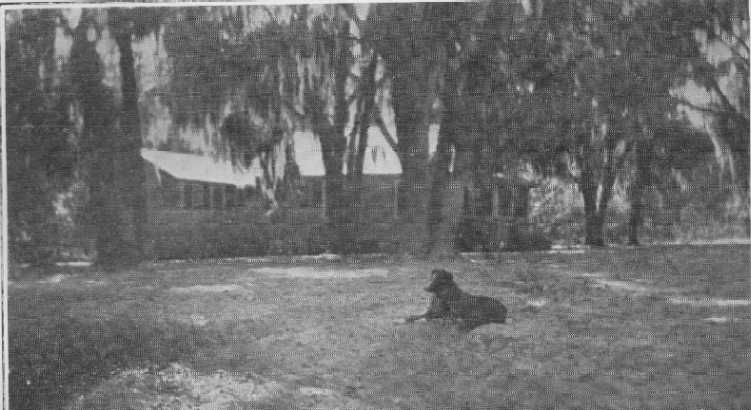
Home at Floral Bluff. ( Bigelow plantation)(arl5.jpg)

Home at Floral Bluff. ( Bigelow plantation)(arl5.jpg)
The topography of Arlington is, for Florida,
unusually broken which contributes to its scenic effect, the deep valley
bottom, containing swift flowing creeks, bordered by dense semi-tropical
growth add great beauty. Much of the area is in original forest consisting
of giant oaks, magnolia, bay, pine and palm, all beautiful either in combination
or separately. The river shore is most picturesque, it being a series of
steep bluffs and gently ascending slopes, capable of development for commercial
purposes or for residences and adaptable for either palace or cottage.
Nothing or anything can be said of the soil
different from that of the rest of Florida, and might be described as spotted.
There is some that will grow anything in profusion that the climate will
allow and all will grow something. It is well adapted to oranges, and at
one time the river banks were lined for miles above and below Arlington
with groves which bore plentifully and of finest flavor but the winters
are some times too cold and frequently many are killed as in 1895 they
nearly all were, since which time that industry has been largely abandoned
though there are yet some very handsome groves in this vicinity but mostly
of a hardier variety of Satsumas and Tangerines. Most other temperate and
semi-temparate fruits do well and all kinds of vegetables can find soil
adapted to them. Both winter and summer gardens are cultivated advantageously
with a nearby ready market.
The climate is delightful. The thermometer
seldom goes above 90° in summer and in winter it freezes only at infrequent
intervals. perhaps going two or three times as low as 30°. Only once
in forty years has there been snow. Without doubt the temperature is influenced
to a great extent by the proximity of the ocean which is only ten miles
east and the river in contact on the west. (see accompanying map). It is
believed there is no more cold than is required for good health. Both the
cold of winter and heat of summer are tempered by almost continuous breezes.
The rains are fairly well distributed through
the year and will average about 55 inches. During summer electric storms
are frequent but nothing in severity compared to what they are in some
of the more mountainous sections of the country. Hurricanes and destructive
storms are nearly unknown, due probably to the configuration of the coast
lines of the Atlantic Ocean and Gulf of Mexico. Few storms cross the Florida
peninsular at latitude 30°-20'.
During a period of forty years there were
but two storms of marked intensity and none that might be termed destructive,
in this locality. Of course the sun is hot in summer as it must always
be in countries where it is nearly vertical, but in the shade comfort can
always be obtained.
In the pioneer period of early Spanish times
there were a few occupants on selected areas, conveyed by the Spanish Government
to favored ones by grants, one of which was the RICHARD MILL GRANT, on
which Arlington is largely situated together with some other grants in
near proximity. During the plantation period, there was an ever increasing
number of large plantations up to the Civil War, devoted to the raising
of cotton, cane and corn, worked exclusively by slave labor, but this period
ended by the freeing of slaves and was followed by several dormant years
and until the beginning of the orange culture. Orange production was the
principal industry for several years but was practically ended by the freeze
in 1895, though since then it has somewhat revived.
In the early seventies people began to settle
in attractive spots to make homes, mostly maintaining their own boats as
a means of transportation to Jacksonville, this was inconvenient and did
not conduce to rapid settlement.

continued on Arlington page 3
...............

